How to Clean Washing Machine (Without Losing Your Mind or Your Socks)
Let’s be real — your washing machine is supposed to clean stuff, right? But what happens when the very thing that’s supposed to clean starts smelling like a wet gym bag that’s been left in the car for a week? Yep, it’s not a fun discovery.
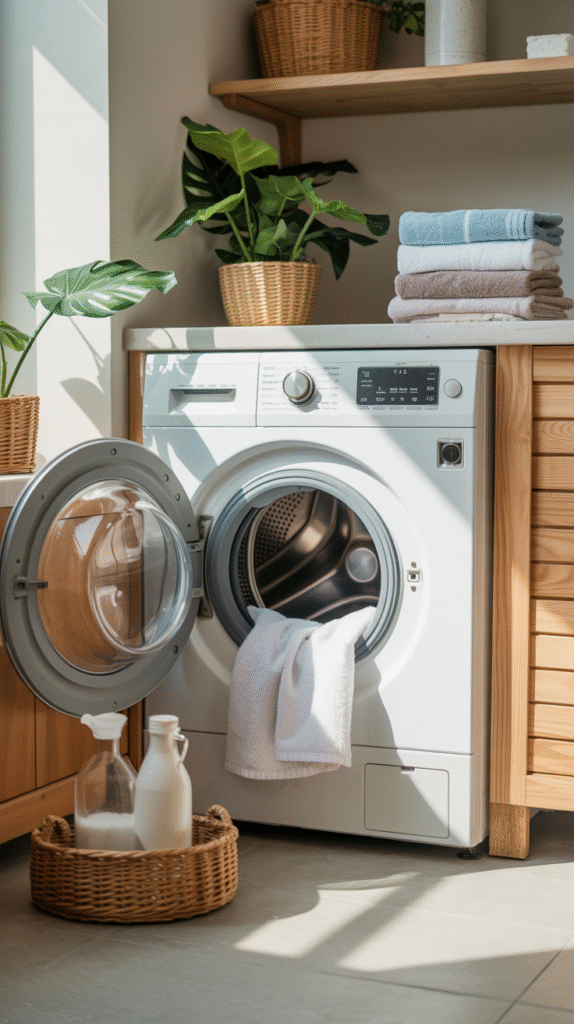
If you’ve ever pulled out your “freshly washed” clothes only to realize they smell worse than before — you’re not alone. I’ve been there. I once blamed my detergent, my water supply, and even my cat (don’t ask) before realizing the problem was my washing machine itself. Spoiler alert: washing machines need cleaning, too.
So grab a towel, a little elbow grease, and maybe your favorite playlist, because we’re diving into how to clean your washing machine properly — both front-load and top-load — and keep it smelling like a mountain breeze (without actually climbing one).
Why You Absolutely Need to Clean Your Washing Machine
You might think, “It’s always filled with soap and water — how dirty can it get?” Oh, friend… you’d be surprised.
Every cycle leaves behind a cocktail of detergent residue, body oils, fabric softener gunk, and lint. Add in humidity, and you’ve basically built the perfect Airbnb for mold and bacteria. Yuck.
Here’s what happens when you skip cleaning your washing machine:
- That musty, mildew smell (you know the one).
- Residue buildup on the drum, gasket, and detergent drawer.
- Clothes that don’t actually smell clean, even after washing.
- Longer cycles and higher energy use because your washer struggles.
- Possible mechanical issues down the line.
So yeah — cleaning isn’t just for looks. It’s for your machine’s health and your sanity.
How Often Should You Clean Your Washing Machine?
Here’s the simple rule of thumb:
- Light cleaning: Once a month.
- Deep cleaning: Every 3 months.
- If you see or smell gunk: Yesterday.
Of course, it depends on how often you do laundry. If your washer is working overtime for a family of five, you might need to clean it more often than someone doing a couple of loads a week.
What You’ll Need
You don’t need anything fancy or expensive. Most of this stuff is already in your kitchen:
- White vinegar – a natural deodorizer and disinfectant.
- Baking soda – tackles residue and funky smells.
- Microfiber cloths or old towels – for wiping surfaces.
- An old toothbrush – for tight corners and seals.
- Optional: Hydrogen peroxide or washing machine cleaner tablets.
- Optional: Rubber gloves (especially if your machine is extra nasty).
How to Clean a Front-Load Washing Machine
Front-loaders look sleek and modern, but man, that rubber gasket is a magnet for mold. If yours smells like a swamp, this section’s for you.
Step 1: Clean the Gasket (a.k.a. The Mold Magnet)
Pull back the rubber seal around the door and brace yourself — what you find may scar you. Lint, hair, coins, forgotten socks… it’s like a crime scene in there.
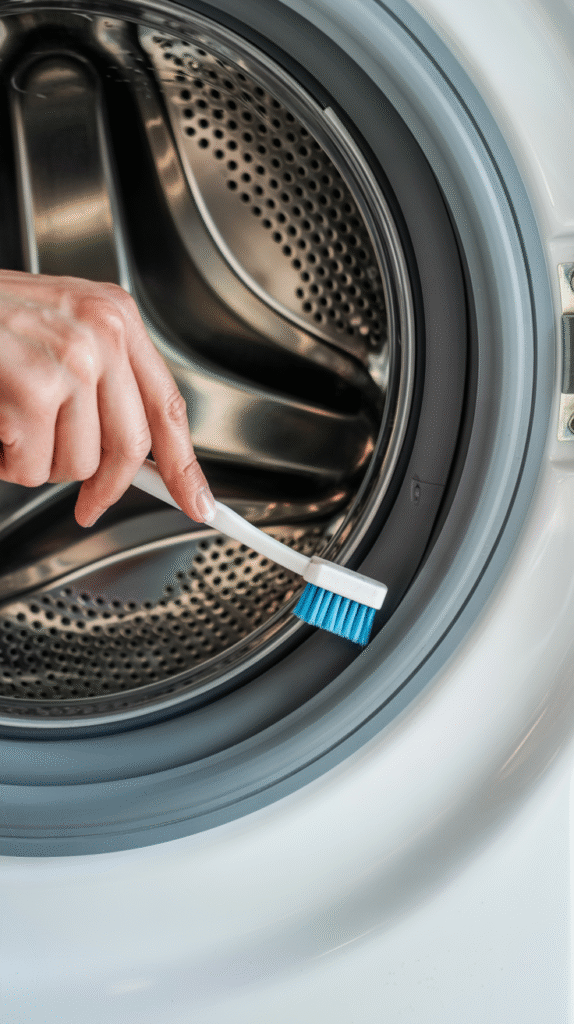
Do this:
- Mix equal parts vinegar and warm water.
- Dip a cloth or toothbrush in the mix.
- Scrub the inside of the gasket — really get in there.
- Wipe it dry with a clean towel.
If you spot black mold, use a 1:1 mix of hydrogen peroxide and water. Let it sit for a few minutes before wiping.
Step 2: Clean the Detergent Drawer
Remove the drawer (it usually slides right out with a little pressure) and rinse it under warm water. Scrub off any buildup with an old toothbrush.
Pro tip: Dry the compartment before putting the drawer back — mold loves damp corners.
Step 3: Run a Vinegar Wash
Pour 2 cups of white vinegar directly into the drum (no clothes!). Run the hottest cycle your machine allows.
Why vinegar? Because it dissolves residue, deodorizes the drum, and fights bacteria — all while being eco-friendly.
Step 4: Run a Baking Soda Rinse
Now sprinkle ½ cup of baking soda into the drum and run another hot cycle. This neutralizes any remaining vinegar and freshens everything up.
Bonus: It makes your drum sparkle. Literally.
Step 5: Wipe Everything Down
When the cycles are done, wipe the door, the drum, and the outside of the machine with a damp cloth. Then leave the door open for a few hours to let it air out.
FYI, that last step is key. A closed door traps moisture — and moisture = mold city.
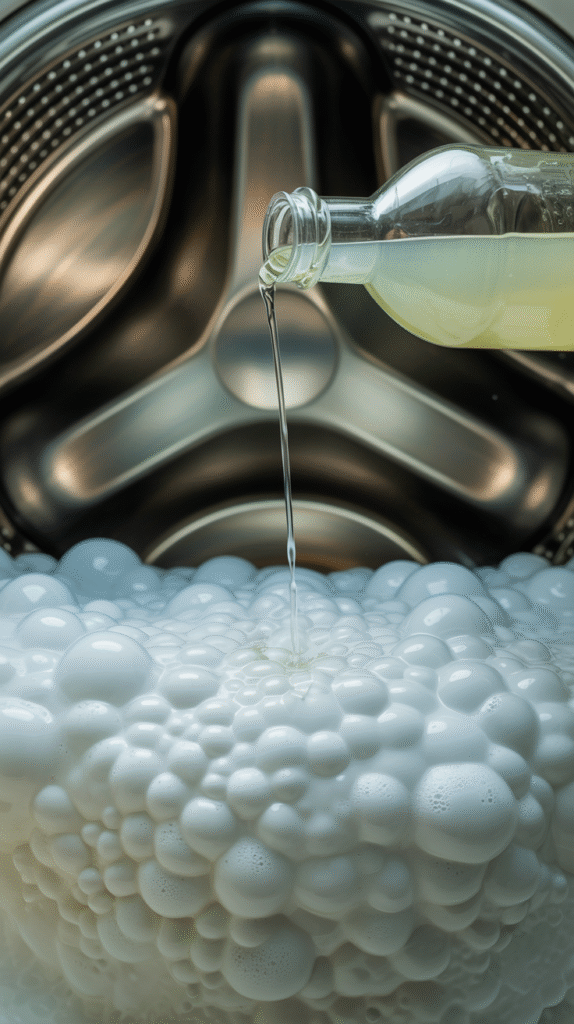
How to Clean a Top-Load Washing Machine
Top-loaders are easier to clean because you don’t have to bend like a gymnast. But they still collect grime, especially under the agitator.
Step 1: Fill It Up with Hot Water
Set your washer to the largest load size and the hottest setting. Let it fill up completely.
Step 2: Add Vinegar
Pour 4 cups of white vinegar into the drum and let it agitate for a minute or two. Then pause the cycle and let it soak for an hour. This breaks down residue and kills bacteria.
Step 3: Scrub Inside Surfaces
While it’s soaking, dip a cloth in the vinegar water and wipe down:
- The lid
- The rim around the drum
- The knobs and controls
- The agitator (if you can reach it)
Then restart the cycle and let it finish.
Step 4: Add Baking Soda
Now run another cycle with 1 cup of baking soda. This rinse will deodorize the drum and balance the pH.
Step 5: Clean the Dispensers
Remove any detergent or softener dispensers and soak them in hot, soapy water. Scrub with an old toothbrush, rinse, and dry before reattaching.
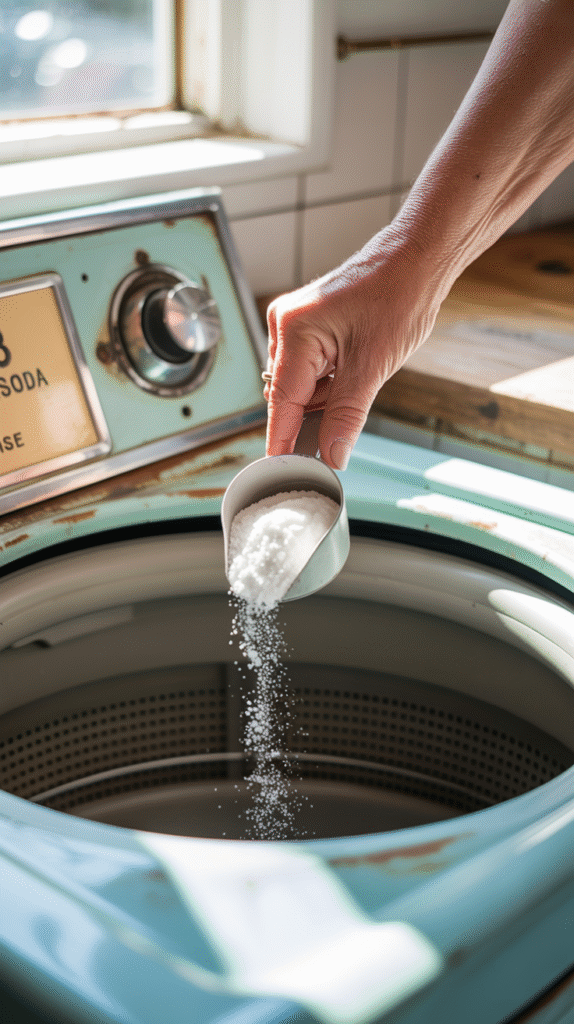
How to Clean the Washing Machine Filter
Yep, your washing machine has a filter — and if you’ve never cleaned it, brace yourself. It’s probably gross.
- Unplug the machine. Safety first!
- Locate the filter (usually near the bottom front or inside the agitator).
- Place a towel underneath — some water might leak.
- Twist open the filter and pull it out.
- Rinse it under warm water and scrub off any debris.
- Reinstall once dry.
A clogged filter can make your washer drain slowly and even leave lint on your clothes. Not fun.
DIY Natural Cleaning Solutions
If you prefer to skip harsh chemicals, good news — nature’s got your back.
Vinegar + Baking Soda Power Duo
These two are like the Batman and Robin of cleaning. Vinegar cuts through grime, and baking soda neutralizes odors. Together, they tackle everything from residue to mold.

Lemon Juice
Add ½ cup of lemon juice to a cycle for a fresh citrus scent. Plus, it helps dissolve limescale buildup.
Hydrogen Peroxide
Perfect for sanitizing without bleach. Just don’t mix it with vinegar — they cancel each other out.
When to Use Store-Bought Cleaners
Sometimes, DIY just doesn’t cut it. If your washer smells like something died in there, try a commercial cleaner like:
- Affresh Washing Machine Cleaner
- OxiClean Washing Machine Cleaner
- Tide Washing Machine Cleaner
These dissolve detergent scum, remove bacteria, and eliminate odors. I usually pop one in every few months as a maintenance boost.
How to Keep Your Washing Machine Clean Longer
You’ve done the hard part — now let’s keep that sparkle going.
1. Leave the Door Open After Every Wash
This one’s simple but powerful. It lets moisture escape and prevents mold from forming.
2. Use the Right Detergent
If you have a high-efficiency (HE) washer, only use HE detergent. Regular detergents produce too many suds and leave residue.
3. Go Easy on Fabric Softener
Too much softener = sticky buildup. Use it sparingly, or switch to dryer sheets or wool dryer balls.
4. Wipe Down After Each Cycle
Quickly wipe the drum, lid, and gasket with a dry cloth. It takes 30 seconds and saves you hours of deep cleaning later.
5. Run Monthly Maintenance Cycles
Run an empty hot-water cycle with vinegar once a month. Think of it as your machine’s “spa day.”
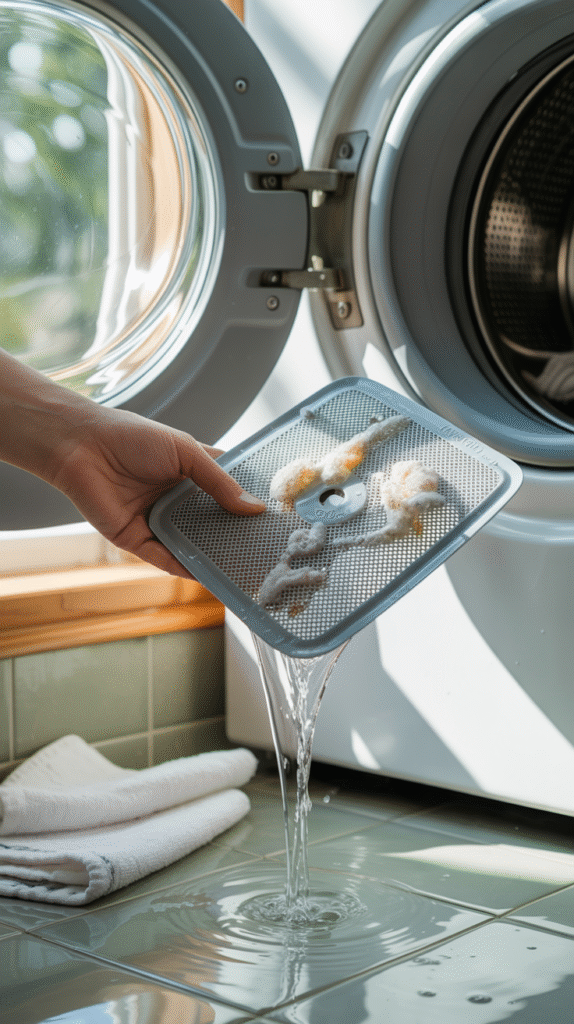
Why Your Washer Still Smells (Even After Cleaning)
If you’ve scrubbed everything and it still smells funky, don’t panic. A few culprits could be to blame:
- Clogged drain hose – mold and gunk love to hide here.
- Blocked filter – often the source of lingering odor.
- Dirty dispenser – detergent buildup can stink.
- Standing water – check if your washer drains completely.
You can usually fix these with a deep clean and by keeping everything dry between uses.
Top Myths About Cleaning Washing Machines
Let’s clear up a few common misconceptions, shall we?
Myth #1: You don’t need to clean your washer.
Reality check: You absolutely do. It’s like never cleaning your shower because “water runs through it.” Yeah, no.
Myth #2: Bleach is the best cleaner.
Bleach kills bacteria but doesn’t remove residue. Plus, it can damage rubber seals over time. Use it sparingly.
Myth #3: Vinegar ruins your washer.
Only if you use it excessively. Once a month is totally fine — it’s gentle, effective, and safe for most machines.
Myth #4: Hot water alone cleans everything.
Hot water helps, but you need something to break down residue. That’s where vinegar or cleaner tablets come in.
Quick Fixes for Common Washing Machine Problems
Sometimes a deep clean reveals other issues. Here’s what to look out for:
Your Washer Smells Like Rotten Eggs
That’s usually bacteria in the drum or drain hose. Run a hot cycle with vinegar and check the filter.
Your Clothes Still Smell Bad
Could be over-loading, using too much detergent, or buildup inside the drum. Try smaller loads and rinse cycles.
Water Isn’t Draining
Check the drain hose and filter. Something might be blocking it (hello, lost socks).
The Door Seal Looks Moldy
Spray a mix of vinegar and hydrogen peroxide, let it sit 10 minutes, and wipe clean.
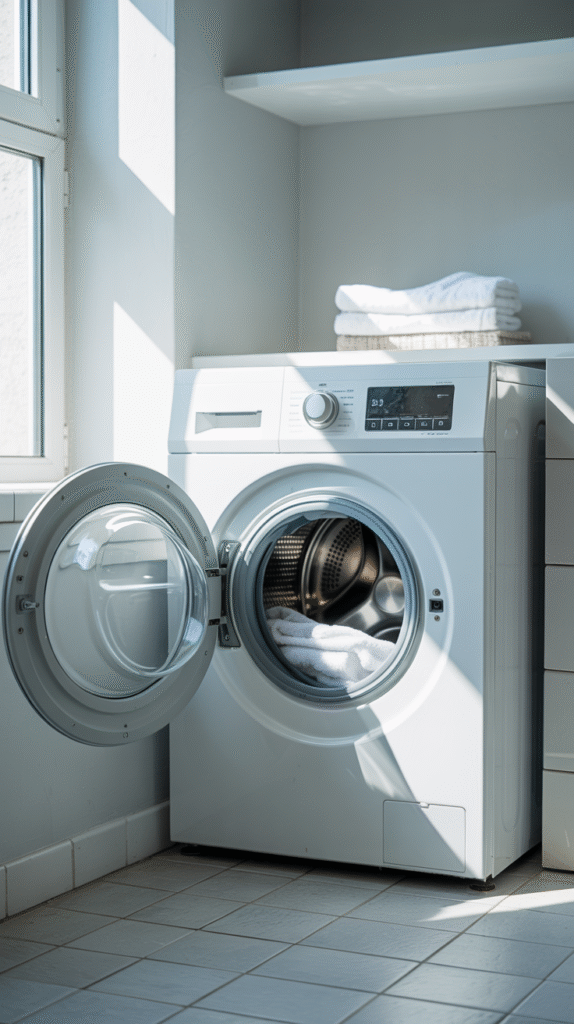
How to Clean Each Washing Machine Part
Here’s a quick reference list for your next cleaning session:
| Part | What to Use | How Often |
|---|---|---|
| Drum | Vinegar + Baking Soda | Monthly |
| Gasket (front-load) | Vinegar + Toothbrush | Monthly |
| Filter | Warm Water + Brush | Every 3 months |
| Detergent Drawer | Hot Soapy Water | Monthly |
| Exterior | Mild Cleaner | As needed |
Bookmark that table — it’ll save you from future laundry disasters.
How to Make Cleaning a Habit (Without Dreading It)
Here’s my trick: pair cleaning day with something fun. Blast your favorite playlist, light a candle, or reward yourself with a snack after. Cleaning doesn’t have to be boring.
Also, set a recurring reminder on your phone: “Hey, it’s washer spa day!” You’ll thank yourself later.
Final Thoughts
So, there you have it — everything you need to know about how to clean your washing machine without losing your sanity (or your nose hairs). Whether you’re team front-load or team top-load, the key takeaway is simple: keep it dry, keep it clean, and treat it like the hardworking appliance it is.
Think of your washer like your car — it takes care of you, so return the favor once in a while. And honestly? Once you smell that crisp, clean laundry again, you’ll never go back to ignoring your machine.
Now go on, give your washer the spa day it deserves — and maybe toss in a few extra dryer sheets for yourself. You’ve earned it. 🙂






